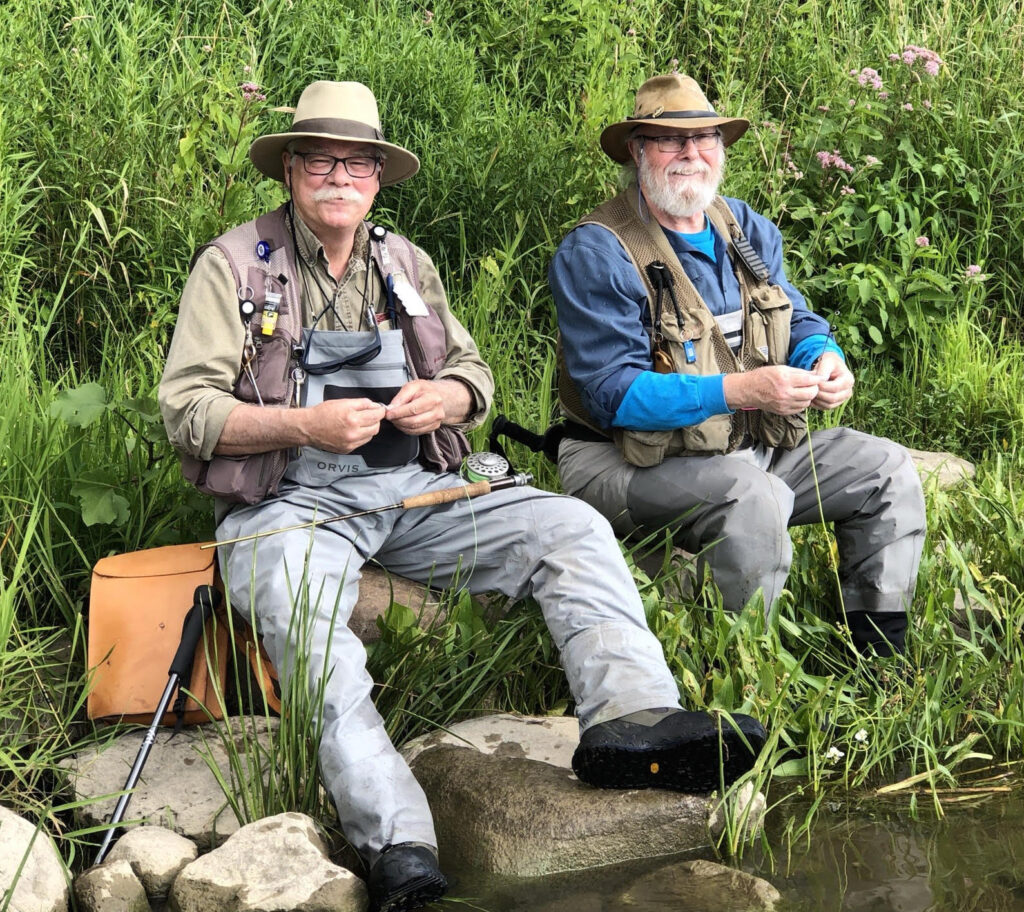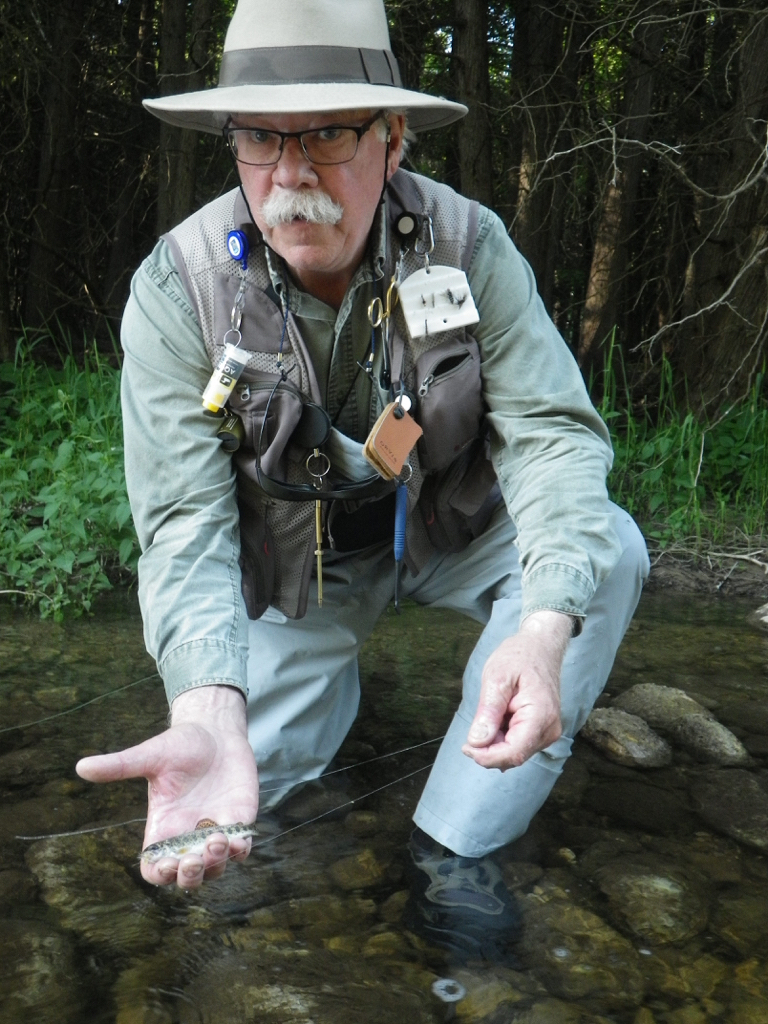A person doesn’t have to peer through the lens of hindsight to see it was inevitable that Wesley Bates and I would work together—someday. Call it fate or destiny, luck or fortune or even synchronicity, one thing is clear: it was neither coincidence nor accident that Casting into Mystery came into being. That’s my story and I’m confident Wes agrees.
I first met Wes in 2001 after he was appointed artist-in-residence at Joseph Schneider Haus, a historical museum in Kitchener, Ontario. I was an arts reporter on the local newspaper and, because I interviewed him and examined the exhibition that comprised a mid-career overview, I knew something he had no way of perceiving. We were creative trout swimming in parallel currents.
I liked Wes immediately. Warm and self-deprecating, modest and articulate, he talked insightfully not only about his engraving method and process, but about the tradition out of which his practice evolved. Although he is adept with brush and pencil, his reputation rests primarily as a master wood engraver. He revealed none of the hesitancy about inspiration and influence, interpretation and meaning that was fashionable among many of the artists I was writing about at the time.
Of course Wes knew nothing about me. However, I was able to determine from his work and his thoughtful answers to my questions that we shared an interest in many of the same things which reflected compatible sensibilities and tastes, attitudes and values. I was not surprised to learn later that we were carved by common experiences.

Despite the objections of modern critical theory concerning ‘biographical fallacy,’ a lifelong study of the arts has taught me that it’s impossible to separate the artist from the art. I have come to know Wes well enough to assert that his art extends from the man and the experiences that shaped him. Were Wes not the artist he is, there would have been insufficient compost for a creative partnership to grow into companionship and fellowship between us.
We are baby boomers born a year apart. Our hairlines have enjoyed fuller days and we are troubled by some of the same medical maladies including finicky hearts and insomnia. Our politics and social values are sympathetic, leaning progressively to the left.
Our fathers were career public servants—Wes’s dad was a Mountie, my dad a firefighter. We both graduated from small liberal arts universities located in smaller communities—Wes graduated from Mount Allison in Sackville, New Brunswick and I graduated from Trent in Peterborough, Ontario. I, too, lived in New Brunswick while attending graduate school.
Although we have lived in many villages, towns and cities throughout our lives, we have always been drawn to rural and wilderness areas. Born in the Yukon, Wes was raised on the Prairies (including the same town celebrated in Wallace Stegner’s masterwork Wolf Willow). He lived in Hamilton before moving to Clifford, Ontario, in the area of the headwaters of the Saugeen River, where we fly fish for trout and enjoy a dram of malt whisky on the riverbank as eventide falls like a comfortable blanket beneath a frieze of bejeweled stars. I was born in London and worked in Strathroy, St. Thomas, Timmins, Simcoe and Brantford before landing in Waterloo (where I have lived in Cambridge, Kitchener and Waterloo).
We look back on comparable early jobs. Wes paid the bills as a bartender and I lugged suitcases as a hotel bell hop. Later we toiled in manufacturing settings. We both worked for newspapers—me as a full-time reporter and Wes as a freelance graphic artist and cartoonist before he assumed the risk and uncertainty—not to mention freedom—of balancing a commercial art business with an independent Letterpress studio and gallery. In 1980 he founded West Meadow Press.
On the commercial side, he has completed commissions for mainstream publishers, engraving images for books by such prominent Canadian writers as Stephen Leacock, W.O. Mitchell, Timothy Findley, Stuart McLean, Don McKay and Dan Needles, among others. On the boutique side, he has published limited edition books including broadsides and artists’ books. He also wrote two illustrated books–The Point of the Engraver and In Black & White: A Wood Engraver’s Odyssey–about his career as a wood engraver. Out of the Dark, his latest book of engravings, is published by Porcupine’s Quill which released Casting in the spring of 2002.
Wes and I have both been married twice, our second wives are/were younger and creative—mine a graphic artist and Wes’s wife, Juanita, a songwriter, vocalist and musician. Wes and I love acoustic roots music as listeners and musicians. Wes plays bouzouki in a band and I play guitar as a respite from the world’s troubling vagaries. We even have the same ‘fashion’ sense. Our closets are interchangeable with brushed-cotton shirts in natural colours; pants of denim, corduroy or khaki; and brown loafers.
Wes’s primary artistic expression is visual, even though he is a fine prose writer. Still I relate to what I view as essentially a literary sensibility. The influence of literature runs deep in his work, from European commedia dell’arte to the British rural tradition of writing and visual art.
Wes’s reading is board and deep. Our personal libraries contain similar kinds of books: art history, literature, nature writing, poetry, essay collections and fly fishing memoirs. Many are the very same books. There’s as many books in Wes’s studio as art supplies and engraving tools, along with Challenge Proof printing press, thirty typefaces, Guillotine paper cutter and trim saw (for cutting wood blocks). We collect books with the enthusiasm of schoolboys trading hockey cards.
I believe creative people fall within two camps: early risers and midnight riders. Wes and I are creative nighthawks. I picture him working into the wee hours, wholly in the present. As the world contracts, distractions recede as the edge of darkness lengths.
In my imagination I picture him nestled in his studio behind the storefront galley in a historic two-storey on Clifford’s main street. He’s hunched over the leather engraving pad placed on his cluttered desk. A vintage snake-neck lamp shines directly from overhead. With burin in his left hand, he carves the end-grain of hard maple, establishing a direct connective tissue among creative imagination, optic nerve and dexterous left hand. (He could just as easily be an angler sitting at a vise tying an artificial fly.) Acoustic music is playing softly in the background, offering a semblance of company.
After first meeting, Wes and I remained in contact intermittently through email for about fifteen years. I had purchased one of his engravings of a fly fisherman landing a trout in a pastoral setting combined with an engraving of an artificial fly. And I hoped my interest would spur him to engrave more images based on fly angling themes. He told me he was slowly, painstakingly developing a graphic story combining fly fishing with ecological themes. I was unsure whether fly fishing was a visual trope in a rural tradition or whether it was something in which he actively participated.
At some point I visited Wes and Juanita to write a newspaper profile on her in anticipation of a concert she was giving in Kitchener. However, it wasn’t until 2016 that acquaintanceship grew into friendship.
The previous year I had started a blog about fly fishing and other passions in response to my retirement from four decades of newspaper work. After some time I began fantasizing about publishing a memoir or essay collection. I had a specific format in mind—an organic blend of text and image that would complement one another like current seams in a river. This led naturally to thinking about the possibility of working with Wes.
The seeds of Casting into Mystery were sown when I met up with Wes and Juanita in Waterloo. I had suggested to the co-owner of Princess Cinemas to invite Wes to the screening of Look & See, a documentary on the life, writing and influence of Wendell Berry. Wes had not only engraved images for a number of the celebrated American agrarian writer’s books, he actually appears in the film. He even designed the movie poster.
After the screening we adjourned to a nearby brewery pub. Between sips to wet our whistles, Wes asked if I would consider working together on a book devoted to fly fishing. I was flabbergasted. I couldn’t believe what I was hearing. He was contemplating the exact creative partnership I had envisioned.
Wes told me he had cast the idea at a couple of other writers without success. Moreover, I was delighted to learn that he was a lapsed fly angler who had taken up the contemplative recreation many years earlier when he and his dad canoed the lakes of interior British Columbia. He confirmed with no small measure of pride that he still possessed the fly rod his parents gave him as a Christmas gift.
Our intent and working method quickly and effortlessly took shape. We agreed our approach would be somewhat unique, resembling two fly anglers in a canoe, paddling together but casting independently from bow and stern. We knew instinctively it was about finding a synchronized creative rhythm. Wes’s engravings would not be conventional illustrations; rather they would comprise a graphic narrative that enhanced and enriched the prose narrative.

Although we worked separately, we cast our sympathetic imaginations into the same creative pool. Most of our informal book talk took place when we got together to toss fur and feather. We fished my home water (tailwater of the Grand River) and Wes’s home water (headwater of the Saugeen).
We exchanged ideas in support of our piscatorial project as we drove together to our river destination, shared stretches of water and toasted the poetry of rivers and the grace of trout over a dram or two or three. We took deep delight in sharing the very experience we were celebrating through word and image in Casting into Mystery.
Wes and I approach fly fishing much as we approach artmaking. We don’t treat the contemplative recreation as a form of aquatic calisthenics. Rather, we take our time, preferring a systematic rather than haphazard technique. Wes fishes through the eyes of an artist, as I fish through the eyes of a writer. Both are aware of the contours of rivers, trees and plants, birds and animals, and clouds swimming high amidst the currents of air.
We share the principle that catching fish isn’t the primary objective. However, just because we are not competitive doesn’t mean we don’t enjoy the sweet joy of catching fish. We do. The more the better. Still, when we wade a river we enter a sanctum sanctorum that inspires us to reflect on the essence of things and to give thanks to our place in the world of nature.
It is enough to be wholly in the present, embraced as we are in the tender arms of mystery, for which we feel profound gratitude.
I don’t know whether writing and engraving share qualities with fly fishing or whether fly fishing shares qualities with writing and engraving. I suspect it’s a creative river that flows both ways, like the river in The Diviners, Margaret Laurence’s last novel. This I know. Writing has taught me to be a better and more appreciative fly angler, as fly angling has taught me to be a better and more appreciative writer. I won’t speak for Wes; but I bet my cherished Sweetgrass bamboo fly rod he acknowledges the same about fly angling and engraving.
Those who would like to read more about Wesley Bates can check out Carving Towards the Light, an essay I first wrote in 2001 and revised for my blog in 2017.